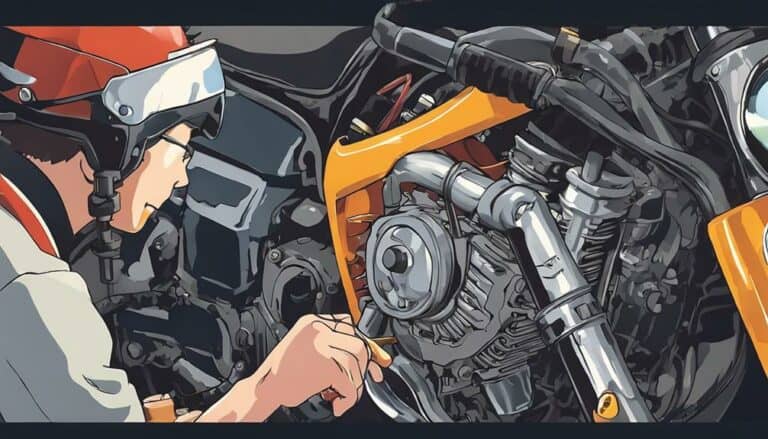When it comes to checking your dirt bike's engine performance, using a cylinder leakage tester is akin to peering inside its soul. You're at a pivotal juncture where precision is key, and the steps you take could expose hidden truths about your engine's well-being.
As you commence on this diagnostic journey, the tools in your hands hold the power to reveal secrets that might otherwise remain elusive.
Key Takeaways
- Prepare the dirt bike and spark plug meticulously before testing.
- Use the correct adapter and ensure a tight seal for accurate results.
- Pressurize the cylinder, listen for hissing sounds, and interpret leakage percentages.
- Leakage percentages indicate the cylinder's health status for necessary action.
Preparing the Dirt Bike
To prepare the dirt bike for cylinder leakage testing, make sure it's parked on a level surface to maintain accuracy in the results. Before testing, you need to remove the spark plug from the cylinder that will be tested. This step guarantees that there's no compression in the cylinder during the test. Once the spark plug is removed, take the time to clean the area around the spark plug hole meticulously. This cleaning process prevents any debris or dirt from falling into the cylinder when the spark plug is out.
After cleaning, it's vital to use the appropriate adapter to securely connect the cylinder leakage tester to the spark plug hole. This adapter guarantees a tight seal, allowing you to get precise readings during the test. Following the manufacturer's instructions for setting up the tester and conducting the test safely is essential. Adhering to these steps will guarantee accurate results and help you diagnose any potential issues with your dirt bike's cylinder effectively.
Removing the Spark Plug
After preparing the dirt bike by parking on a level surface and cleaning around the spark plug hole, the next step involves removing the spark plug using a spark plug socket and wrench. Begin by disconnecting the spark plug wire to avoid any accidental ignition.
Carefully unscrew the spark plug with the appropriate tools to prevent damage to the threads. Once removed, take a close look at the spark plug. Inspect the electrode for signs of fouling, wear, or damage, which can indicate potential engine issues. Check the insulation around the electrode for any cracks or abnormalities that may affect the spark plug's performance.
Handle the spark plug with care and store it in a safe place to prevent any harm. By examining the spark plug closely, you can gain valuable insights into the combustion process of your engine, helping you diagnose and address any underlying problems efficiently.
Connecting the Leakage Tester
When connecting the leakage tester for a dirt bike cylinder test, make sure the engine is positioned at top dead center compression. This guarantees accurate results during the test.
To connect the leakage tester properly, follow these steps:
- Adapter Selection, Troubleshooting: Choose the correct adapter that securely fits into the spark plug hole. An ill-fitting adapter can lead to inaccurate test results. If you encounter any issues with the adapter, troubleshoot by checking for any obstructions or damage that could impact the seal.
- Leakage Detection, Troubleshooting: Connect the leakage tester to the adapter and ensure a tight seal to prevent air leakage. Once connected, apply compressed air to pressurize the cylinder. Monitor the gauge for any signs of leakage and listen for hissing sounds, which can help pinpoint the source of any leaks.
- Test Accuracy, Maintenance: To maintain test accuracy, regularly inspect the adapter and tester for any wear or damage. Proper maintenance of the equipment guarantees reliable results every time you perform a cylinder leakage test on your dirt bike.
Performing the Leakage Test
Guarantee that the engine of your dirt bike is correctly positioned at top dead center compression before proceeding with the cylinder leakage test. Utilize the Motion Pro four-stroke leak down tester to pressurize the cylinder.
Make sure the engine remains stationary during the test to obtain precise results. Listen keenly for any hissing sounds, which can indicate the location of leaks within the cylinder. Troubleshooting leaks involves identifying potential issues that could be causing compression loss.
By understanding the results, you can interpret the percentage of leakage detected and evaluate the overall condition of the engine. This step is important in determining the health of your dirt bike's engine and can guide you in making necessary repairs or adjustments to improve performance.
Always follow the manufacturer's guidelines and recommendations for best testing procedures.
Interpreting the Test Results
To accurately interpret the results of the cylinder leakage test on your dirt bike, analyze the leakage percentage detected within the engine cylinder.
- A leakage percentage of 0-10% indicates a well-sealed and healthy engine cylinder.
- If the leakage percentage is between 10-20%, there may be minor issues or wear present.
- Leakage levels of 20-30% suggest moderate problems that require attention and further investigation.
When analyzing the results, keep in mind that listening for hissing sounds can help pinpoint specific areas of leakage within the cylinder during the test. If you hear a hissing sound, focus on that area to determine the source of the leak.
Understanding the implications of the leakage percentage is essential for troubleshooting and addressing any issues promptly. Remember, a higher percentage indicates more severe problems, so taking action based on the results is vital for maintaining the performance and longevity of your dirt bike.
Conclusion
To sum up, after conducting the cylinder leakage test on your dirt bike, you'll either breathe a sigh of relief at the pristine engine health or feel like you've just uncovered a Pandora's box of leaks and issues waiting to burst open.
The test results serve as a window into the engine's inner workings, revealing its secrets and potential pitfalls.
So, strap in and prepare for a rollercoaster of emotions as you explore the world of cylinder leakage testing.

